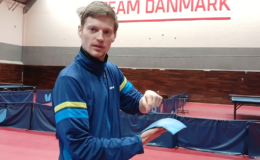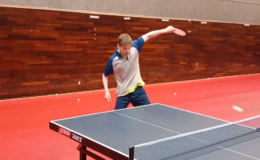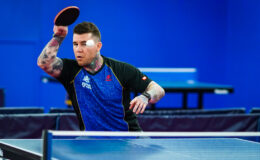Perfecting Your Serve
Improving your serve is the fastest way to progress your game. In this article, I will be outlining nine ways that I personally use to perfect my serve:
#1 Use the serves that best setup your game
#2 Train them in a tournament environment
#3 Miss some serves
#4 Use your best serves early
#5 Vary the quality of spin
#6 Remember to attack
#7 Be willing to sacrifice a couple points
#8 Train them to perfection
#9 Play practice matches
The most important aspect of serving is to use the serves that most effectively setup your game. Even if you can’t win the point with an “ace”, at least you can setup the point to play in the style that best suits your game. If you are a looper, then most of your serves should be short, low backspin. If you are a pips-out attacker, you should serve mostly fast and long with good placement. If you are a chopper, then you should serve deep spinny serves. So take time now to outline your game-plan so that you will have a clear understanding of your style and the strengths in your game. Once you have determined which serves best setup your game, you can develop a motion in which you can serve either short or long with at least two different spins (all using the same motion).
When practicing your serves, do them in a simulated tournament environment.
First, try to be tired when you serve. Do jumping jacks or footwork so that your hand will be sweaty and it will be challenging to concentrate.
Second, practice in tournament conditions. Try to use a tournament table and 3 star balls so that the bounce will be similar to what you will be using in the tournament. If you are trying to serve short, the ball will probably go slightly longer in the tournament. For this reason, I suggest covering the last three inches on the opponent’s side of the table when practice you serves. This will force you to serve slightly shorter during practice.
Third, when doing serve practice, think of specific opponents. What serves have worked well against this opponent previously? How would this particular opponent receive this serve?
Fourth, use these same serves at the club. Don’t save your serves for a tournament – be willing to use them in practice matches. In practice, you should try to put so much spin on the ball, that you will miss about 25% of your serves. If you are not missing any serves, that is a good indication that you are not trying hard enough.
In tournaments, you should usually miss about one serve per match. If you miss too many serves, you will be hurting yourself. By serving your best serves early, you can build an initial lead in the match and gain confidence. I recently beat an opponent who had a very tricky serve. In three games, I only returned one out of seven of these particular tricky serves. However, I won the match 3-0 in games. Once the serve started working against me, he should have continued using it. He wanted to save it for “a closer”, which never came because he lost 3-0 in games. As I mentioned in the above paragraph, if a serve is working, keep using it! If you change your serve too often, you might confuse yourself.
Instead of jumping from one serve to another, sometimes use the same serve with the same spin, but vary the quality of spin. For example, on the forehand pendulum serve, I might sometimes serve heavy back-sidespin sometimes medium and sometimes light. My opponent probably won’t outright miss my serve, but he may give me an easier return. Remember to attack. Your serve will seem ten times more threatening if it is backed by a vicious attack. If your opponent is trying to keep you from attacking, he will make many mistakes trying to keep the ball short and low.
Personally, my serves work the best when my attacking game is at its best. During the game, be willing to sacrifice a couple points. Many players are afraid to serve long against a looper, so they always serve short. This allows the looper to stay closer to the table when returning serve and be prepared for the short serve. Sometimes you must serve fast down-the-line or to the backhand just to keep the opponent guessing. You might lose a point, but all your short serves will be much more effective later.
When practicing serves, train them to perfection. Focus for 30 minutes on one particular serve. Take your time and analyze it serve by serve – what you did right and what you did wrong. Study how the world’s top players serve that particular serve, by watching their backswing, body movement, contact point, racket angle, follow through, and ball positioning. Also, be willing to hire a professional coach to help perfect your main serve.
The final link to professional serves is to use them in actual games. Use them in practice matches and use them in tournaments. Improving your serve is the fastest way to progress your game. Use the nine techniques listed above and you will be seeing excellent results within a few weeks!





